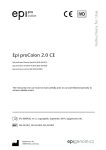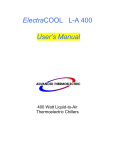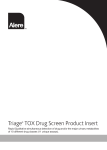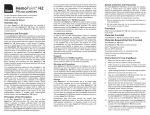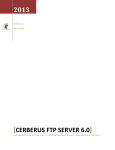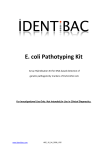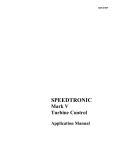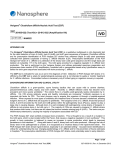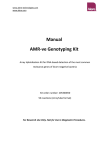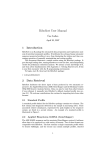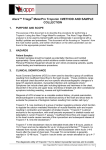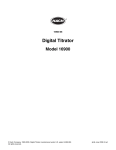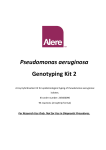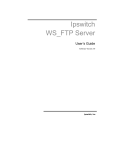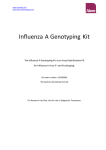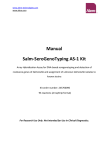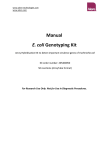Download Manual C.diff-Type AS-1 Kit
Transcript
www.alere-technologies.com www.alere.com Manual C.diff-Type AS-1 Kit Array Hybridisation Kit for DNA-based detection of resistance genes and pathogenicity markers of Clostridium difficile and assignment of unknown C. difficile isolates to known strains Kit order number: 246100096 96 reactions (ArrayStrip format) For Research Use Only. Not for Use in Diagnostic Procedures. www.alere-technologies.com www.alere.com CONTENT BACKGROUND ................................................................................................................................. 1 GENERAL INSTRUCTIONS FOR USE .................................................................................................. 2 Intended Use .............................................................................................................................. 2 Specifications .............................................................................................................................. 2 Technical Support ....................................................................................................................... 2 Safety Precautions ...................................................................................................................... 3 Material Safety Data Sheets (MSDS) .......................................................................................... 3 Shipping Precautions .................................................................................................................. 3 REAGENTS AND DEVICES ................................................................................................................. 4 Kit Components, Storage and Stability ....................................................................................... 4 Cell Lysis (optional order) ......................................................................................................... 4 DNA Labelling and Amplification .............................................................................................. 4 Hybridisation and Detection..................................................................................................... 5 Instrumentation and Software ................................................................................................. 6 Components Required but not Provided ................................................................................. 6 PROTOCOLS ..................................................................................................................................... 8 Culturing and Harvesting Bacterial Cells .................................................................................... 8 DNA Extraction ........................................................................................................................... 8 DNA Extraction by Spin Columns (e.g. Qiagen) ........................................................................ 9 DNA Extraction by Automated Device ................................................................................... 11 Linear Amplification and Internal Biotin Labelling ................................................................... 11 Hybridisation ............................................................................................................................ 13 General Remarks - Handling of Arrays ................................................................................... 13 General Remarks - Handling of Liquids .................................................................................. 14 General Remarks - The Substrate (Precipitating Dye) D1 ...................................................... 14 General Remarks - Thermoshakers ........................................................................................ 15 Protocol for Quantifoil’s BioShake iQ ..................................................................................... 16 Data Analysis............................................................................................................................. 18 Starting the ArrayMate Reader .............................................................................................. 18 Worklist................................................................................................................................... 18 Data Acquisition in the ArrayMate Reader ............................................................................ 20 Results..................................................................................................................................... 22 Export of C.diff-Type AS-1 Kit Test Reports ............................................................................ 25 TROUBLESHOOTING ...................................................................................................................... 26 Staining Control ........................................................................................................................ 26 Image Quality............................................................................................................................ 27 C.diff-Type AS-1 Kit 05_16_04_0019_V01_Manual C.diff-Type AS-1 Kit www.alere-technologies.com www.alere.com DNA Quality and RNA Contamination Control ......................................................................... 27 Physical Damage to the Array .................................................................................................. 28 Report Unavailable ................................................................................................................... 28 Ambiguous Results ................................................................................................................... 28 Error Messages in Result Sheets .............................................................................................. 29 ADDITIONAL INFORMATION ......................................................................................................... 30 Warranty ................................................................................................................................... 30 Disclaimer ................................................................................................................................. 30 Quality Control ......................................................................................................................... 31 List of Components for Separate Order ................................................................................... 31 Legal Manufacturer .................................................................................................................. 31 Contact...................................................................................................................................... 31 LITERATURE ................................................................................................................................... 32 UPDATES AND SOFTWARE ............................................................................................................ 33 APPENDIX 1 – FLOW CHART .......................................................................................................... 34 APPENDIX 2 – IMAGES FOR TROUBLESHOOTING ......................................................................... 35 APPENDIX 3 – PROBE TO TARGET TABLE ...................................................................................... 38 APPENDIX 4 – TYPING INFORMATION .......................................................................................... 41 Definitions and Explanations .................................................................................................... 41 List of Currently recognized Strains .......................................................................................... 42 C.diff-Type AS-1 Kit 05_16_04_0019_V01_Manual C.diff-Type AS-1 Kit www.alere-technologies.com www.alere.com BACKGROUND Clostridium difficile is a component of the human colonic flora. If the physiological bacterial flora in the colon is damaged by administration of antibiotics, especially of clindamycin, fluoroquinolones, cephalosporins, or amoxicillin/clavulanic acid, C. difficile is able to multiply and to cause antibiotic-associated diarrhoea and pseudomembranous colitis [1]. Severe cases might progress to toxic megacolon and end fatally. C. difficile can cause antibiotic-associated diarrhoea and a possibility of outbreaks in hospital settings warrants molecular typing. The microarray based assay facilitates rapid and high-throughput genotyping of clinical C. difficile isolates including toxin gene detection and strain assignment. The C.diff-Type AS-1 Kit allows DNA-based detection of resistance genes and pathogenicity markers of C. difficile and assignment of unknown C. difficile isolates to known strains. RNA-free, unfragmented genomic DNA from pure and monoclonal C. difficile colony material is amplified and internally labelled with biotin-dUTP using a linear amplification protocol. In contrast to standard PCR, only one antisense primer per target is used resulting in single stranded (ss) DNA reaction products. This allows a simultaneous sequence specific labelling and amplification of an essentially unlimited number of targets. However, sensitivity is lower than in a standard PCR (whereas contamination with undesired amplicons is nearly impossible) and for that reason the method is restricted to colony material and cannot be performed on samples such as swabs or pus. The resulting biotin-labelled ssDNA is transferred and hybridised to DNA oligonucleotide microarrays with 336 probes for different genetic markers and a biotin staining control. Most of them are printed in two duplicate spots. Spot recognition is performed automatically based on digital images of the arrays. The overall pattern is analysed automatically for the presence or absence of specific genes and it is compared to a database of strain profiles allowing assignment to clonal complexes and strains. C.diff-Type AS-1 Kit 05_16_04_0019_V01_Manual C.diff-Type AS-1 Kit 1 www.alere-technologies.com www.alere.com GENERAL INSTRUCTIONS FOR USE Intended Use For Research Use Only. Not Intended for Use in Clinical Diagnostics. This kit allows genotypic characterisation of bacterial cultures from C. difficile isolates for research and epidemiological applications. It must not be used as a substitute for phenotypic susceptibility tests and for the guidance of antibiotic therapy. It cannot be used for other bacteria than C. difficile. Specifications Upon receipt, the kit components need to be stored at different temperatures as specified on the package insert. The assay is to be performed at an ambient temperature of 18 °C to 28 °C. Technical Support If you require any further information on this product please contact: Email: [email protected] Phone: +49 (0) 36 41 3111-155 Fax: + 49 (0) 36 41 3111-120 For up-to-date information regarding the kit, please visit our website at http://www.alere-technologies.com C.diff-Type AS-1 Kit 05_16_04_0019_V01_Manual C.diff-Type AS-1 Kit 2 www.alere-technologies.com www.alere.com Safety Precautions The kit is intended for use by personnel that are trained in microbiological and molecular methods. Preparation of DNA from pure C. difficile colonies (clones) requires expertise in microbiology, and the local regulations for handling of pathogenic microorganisms (biosafety level 2) are to be obeyed. Isolated, cell-free C. difficile DNA may be processed without further biosafety precautions, although contamination with C. difficile or other bacteria needs to be ruled out. Always wear protective clothes as required for laboratory work by your local regulations. Material Safety Data Sheets (MSDS) According to OSHA 29CFR1910.1200, Commonwealth of Australia [NOHSC: 1005, 1008(1999)] and the latest regulations (EC) 1272/2008 (CLP) and 1907/2006 (REACH), the enclosed reagents do not require a Material Safety Data Sheet (MSDS), except Hybridisation Buffer C1. The MSDS can be downloaded via our website from any lab solutions product page (e.g. http://aleretechnologies.com/en/products/lab-solutions.html). All other reagents do not contain more than 1 % of a component classified as hazardous and do not contain more than 0.1 % of a component classified as carcinogenic. Nevertheless, the buffers may cause irritation if they come into contact with eyes or skin, and may cause harm if swallowed. The regular precautions associated with laboratory work should be obeyed (e.g., wear protective goggles, gloves and lab coat and avoid contact with the reagents). If liquid is spilled, clean with a disinfectant and/or laboratory detergent and water. Alere assumes no liability for damage resulting from handling or contact with these products. If you have any questions please contact our Technical Support (see above). Shipping Precautions RID/ADR: Kein Gefahrgut / No dangerous goods IMDG: No dangerous goods C.diff-Type AS-1 Kit 05_16_04_0019_V01_Manual C.diff-Type AS-1 Kit 3 www.alere-technologies.com www.alere.com REAGENTS AND DEVICES Kit Components, Storage and Stability All reagents are provided in surplus (see below). If necessary, all components may be ordered separately. Please refer to the catalogue reference numbers (Cat#) at the end of this manual. For pricing please contact your local representative or our customer service, respectively. The expiry date can be found on each bottle and on the outer packaging. All components were tested for short term shipment (< 1 week) at ambient temperature (< 37 °C). The assay components with limited stability are D1 and C3. The other kit components proved to be stable six months after post expiry. Cell Lysis A1: Lysis Buffer Store at 18 to 28 °C (ambient temperature). Surplus: 50 %. A2: Lysis Enhancer (dried) Store at 18 to 28 °C (ambient temperature). Centrifuge A2 tubes shortly prior to opening. Add 200 µl Buffer A1 to Lysis Enhancer before use. Mix well and store for less than 1 week at 2-8 °C. Sufficient for 96 isolations. DNA Labelling and Amplification B1+: Labelling Buffer/Master Mix Store at 2-8 °C. Surplus: 25 %. B2: Labelling Enzyme Store at 2-8 °C. Surplus: 50 %. B3Cdi: Primermix: dried Labelling Primermix, two tubes, dilute each primer mix in 70 µl molecular grade water. Store at -20 °C. Surplus: 50% C.diff-Type AS-1 Kit 05_16_04_0019_V01_Manual C.diff-Type AS-1 Kit 4 www.alere-technologies.com www.alere.com Hybridisation and Detection ArrayStrips (12 x 8 samples) Protected against light and sealed under inert gas. Store at 18-28 °C. After opening to be used within two weeks. Close the unused wells with caps, protect them against humidity and dust, and store them in a dark place. Avoid any touching or scratching of the microarray surface at the bottom of the well. Do not store or handle unused wells at more than 60 % relative humidity since this may irreversibly corrode the spots. StripCaps (24 units) C1: Hybridisation Buffer Store at 18-28 °C, protect against direct sunlight. Surplus: 100 %. C2: Washing Buffer 1 Store at 18-28 °C, protect against direct sunlight. Surplus: 200 %. C3: HRP Conjugate 100 x Store at 2-8 °C, protect against direct sunlight. Surplus: 100 %. C4: Conjugate Buffer Store at 18-28 °C, protect against direct sunlight. Surplus: 200 %. C5: Washing Buffer 2 Store at 18-28 °C, protect against direct sunlight. Surplus: 200 %. D1: Horseradish Peroxidase Substrate Store at 2-8 °C, protect against direct sunlight. Surplus: 50 %. C.diff-Type AS-1 Kit 05_16_04_0019_V01_Manual C.diff-Type AS-1 Kit 5 www.alere-technologies.com www.alere.com Instrumentation and Software ArrayMate Reader (to be ordered separately, for details see below) The ArrayStrip based C.diff-Type AS-1 Kit can be used on the ArrayMate reader only. The alternative devices ATR01/03 are not suitable for reading ArrayStrip based assays. In case of any questions please contact us. Iconoclust software (provided with the reader) Test specific software plug-in (can be downloaded from Alere Technologies GmbH website, check periodically for updates, for details see below). Information (such as spot names, marker names, location of the spots on the array, size of the image taken by the reader’s specific camera) is delivered with the reader or can be downloaded from our website. These test specific plug-ins will occasionally be updated. Please check the NEWS section of our website http://alere-technologies.com/. Support is available via [email protected]. Components Required but not Provided Growth media for the cultivation of C. difficile (for discussion of suitable media, see below). Equipment and consumables needed for the cultivation of C. difficile (incubator, anaerobic jars and catalysts, inoculation loops, Petri dishes) Additional assays for confirmation of species identification DNA preparation kit: The assay was tested with the DNeasy Blood & Tissue Kit from Qiagen (cat# 69504), QIAamp Minikit (cat# 51306) and a DNA preparation kit for Qiagen´s EZ1 automated device (DNA Tissue Kit, cat# 953034). Please note: DNA isolation from C. difficile requires a pre-treatment with the Cell Lysis components A1/A2 (see below). Equipment needed for DNA isolation, e.g., pipettes, centrifuge, thermoshaker or automated device (see above) Photometer for measuring the concentration of DNA C.diff-Type AS-1 Kit 05_16_04_0019_V01_Manual C.diff-Type AS-1 Kit 6 www.alere-technologies.com www.alere.com Equipment for DNA gel electrophoresis for quality control of DNA Thermocycler Thermoshaker We strongly recommend the BioShake iQ by Quantifoil Instruments (http://www.qinstruments.com/) equipped with a customised heating block designed to fit ArrayStrips (# 312-010 | BioShake iQ - Alere® ArrayStrip). Alternatively, you may use Eppendorf’s Thermomixer Comfort, equipped with a heating block for microtitre plates. Pipettes: suitable for volumes of 1 µL-5 µL, 90 µL, 100 µL, 200 µL, 1000 µL Multichannel Pipettes for 100-200 µL Reagent tubes suitable for PCR (VWR Cat# 732-0098) Ultrapure (PCR-grade) water Pasteur pipettes (VWR Cat# 612-2856) C.diff-Type AS-1 Kit 05_16_04_0019_V01_Manual C.diff-Type AS-1 Kit 7 www.alere-technologies.com www.alere.com PROTOCOLS Culturing and Harvesting Bacterial Cells C. difficile is a potential pathogen. All procedures for cultivation of the bacterium and DNA preparation need to be performed by properly trained staff in a biosafety level 2 facility. C. difficile can be isolated under anaerobic growth conditions from faecal samples using pretreatment with ethanol in order to kill off other bacteria and/or cycloserinethanol-cephoxitinfructose-agar (e.g., Oxoid, Cat. Nr. PB5054A). Pre-reduction of the agar under anaerobic conditions or in an incubator with increased C02 concentration will improve recovery rates. Since a comparatively high amount of DNA is required (because of the linear amplification, see below), single colonies from a primary culture usually do not suffice. Therefore, a single colony should be picked and used to inoculate several plates of blood or Schaedlar agar, or, more conveniently, a vial of Schaedler broth. The subculture should be incubated again (48 hrs at 37 °C and under anaerobic conditions), and cultures be harvested or, respectively, centrifuged. Centrifuge A2 tube briefly, open it, add 0.2 mL of Lysis Buffer A1 to Lysis Enhancer A2 and dissolve. Add some inoculatings loops full of monoclonal culture material of the C. difficile isolate, or the sediment of centrifuged liquid culture, into this A1/A2 reagent, vortex. DNA Extraction The required sample type for the C.diff-Type AS-1 Kit is 0.5-2 µg (cDNA=0.1-0.4 µg/µl) of intact genomic DNA from a single clone. This is much more DNA than for standard PCR applications (see Introduction). The DNA specimen needs to be free of RNA and it should not be fragmented. C.diff-Type AS-1 Kit 05_16_04_0019_V01_Manual C.diff-Type AS-1 Kit 8 www.alere-technologies.com www.alere.com This can be determined by agarose gel electrophoresis. DNA should not be prepared by disrupting C. difficile cells using bead beaters, ultrasonication or aggressive chemicals such as in alkaline lysis protocols. Most performance problems with the C.diff-Type AS-1 Kit are due to insufficient amounts or quality of DNA preparation. We therefore strongly recommend obeying the protocols outlined below. DNA Extraction by Spin Columns (e.g. Qiagen) Centrifuge A2 tube shortly, open it, add 0.2 ml of Lysis Buffer A1 to Lysis Enhancer A2 and dissolve. Add culture material of the C.difficile isolate (as described above) to this A1 / A2 reagent and vortex thoroughly. Incubate the culture material of the C.difficile isolate in A1 / A2 for 30-60 min at 37 °C and 550 rpm in the thermoshaker. Proceed with the DNA preparation protocol of the DNA preparation kit. For the Qiagen DNeasy Blood&Tissue Kit it is as follows: Add 25 µl proteinase K (from Qiagen Kit, or equivalent) and add 200 µl buffer AL (Qiagen Kit). Vortex shortly or shake vigorously. Incubate for 30-60 min at 56 °C and 550 rpm in the thermoshaker. Important: If A1/A2 reagent is not used, add now 4 μl RNase A (100 mg/ml), mix by vortexing, and incubate for 2 min at room temperature before continuing. Add 200 µl ethanol (96 - 100 %). Vortex the sample and centrifuge (quick spin). Transfer the complete tube content (including any precipitate) into a spin column that is placed in a 2 ml collection tube. Centrifuge (8,000 rpm, 1 min) at room temperature. Time and speed need to be determined depending on the sample viscosity and the type of centrifuge used. All liquid should be collected in the collection tube afterwards. C.diff-Type AS-1 Kit 05_16_04_0019_V01_Manual C.diff-Type AS-1 Kit 9 www.alere-technologies.com www.alere.com Discard collection tube with liquid. Place the spin column in a new 2 ml collection tube (provided with the kit). Add 500 µl Buffer AW1. Centrifuge (8,000 rpm, 1 min) at room temperature. Discard collection tube with liquid. Place the spin column in a new 2 ml collection tube (provided with the kit). Add 500 µl Buffer AW2. Centrifuge (14,000 rpm, 3 min) at room temperature. The membrane of the spin column should be dry, and all liquid should be in the collection tube. Discard collection tube with liquids. Place the spin column in a clean 1.5 ml tube (not provided with the kit). Add 100 µl Buffer AE (or PCR grade distilled water) directly onto the membrane of the spin column. Incubate at room temperature for 1 min to elute DNA. Centrifuge (8000 rpm, 1 min) at room temperature. Optional: Add another 100 µl Buffer AE (or PCR grade distilled water) directly onto the membrane, incubate at room temperature for 1 min and centrifuge again. Discard the spin column. Please note: Ethanol from Washing Buffers strongly inhibits the enzymes used in the assay. Contamination with Washing Buffer might occur during the elution of prepared DNA by drops adhering to the spin columns funnels. Therefore these funnels should be gently touched and dried with sterile filter paper or wipes prior to the elution step. Alternatively, prepared DNA can be heated shortly to evaporate ethanol (e.g. 10 min at 70 °C). C.diff-Type AS-1 Kit 05_16_04_0019_V01_Manual C.diff-Type AS-1 Kit 10 www.alere-technologies.com www.alere.com Check for DNA integrity and absence of RNA (e.g. agarose gel). If necessary, you might perform another digestion step with additional RNase A (not provided). Measure DNA concentration (A260 method); it should not be lower than 0.1 µg / µl. The concentration might be increased by heating and evaporating water, or by using a speed vac centrifuge (not recommended when the same preparation shall be used in PCR experiments). DNA Extraction by Automated Device The assay was tested with Qiagen´s EZ1. Other systems also can be used as well. However, performance should be checked with some known reference strains prior to routine use. Incubate the colony material of the C. difficile isolate in A1/A2 for 30-60 min at 37 °C and 550 rpm in the thermoshaker as described above (depending on the input sample volume required by the device you actually use, the A1/A2 mixture might be divided into two aliquots, and used for DNA preparation of two samples). Add 10 µL proteinase K and add 100 µL buffer AL. Vortex briefly or shake vigorously. Incubate sample 45-60 min at 56 °C and 550 rpm in the thermomixer. When the cells are lysed, proceed by performing the tissue lysis protocol (Bacteriacard) for Qiagen´s EZ1 For Qiagen´s EZ1: Front row: empty elution tubes (1.5 mL); second row: tip holder with tips; third row: empty; back row: sample tube with conical tip (2 mL) containing the 200 µL sample volume. Set tissue lysis protocol with a set sample volume of 200 µL and an elution volume of 50 µL. Concentrate DNA and evaporate traces of solvents by heating the sample at 70 °C for 5-10 min. Linear Amplification and Internal Biotin Labelling Please keep in mind the limited surplus of reagents whilst pipetting. The surplus of B1+ labelling reagent is 40%. C.diff-Type AS-1 Kit 05_16_04_0019_V01_Manual C.diff-Type AS-1 Kit 11 www.alere-technologies.com www.alere.com Prepare a Master Mix by combining 3.9 µL of B1+ labelling reagent, 0.1 µL of B2 labelling enzyme and 1.0 µl of B3Cdi primer mix per sample. Add 5 µL DNA (0.5-2 µg) prepared as described above to a 5 µL aliquot of the Master Mix. Do not forget to label the vial! Perform amplification in a pre-programmed thermocycler (such as Mastercycler gradient with heated lid, VWR, cat# 460-0108) according to the following protocol: Pre-heat cover / lid to 105 °C 300 sec at 96 °C 60 sec at 96 °C 55 cycles with: 20 sec at 50 °C 40 sec at 72 °C Cool down to 4 °C, hold The amplification products can be stored frozen until usage. Please note: When using a different device, some adaptations, such as an increase of the number of cycles, might be necessary. Before establishing routine use, please test the protocol with a few known reference strains or the control DNA (CM) supplied upon request. We recommend as reference strain the following: Clostridium difficile DSM No.: 27543 Strain designation: 630 https://www.dsmz.de/catalogues/details/culture/DSM-27543.html C.diff-Type AS-1 Kit 05_16_04_0019_V01_Manual C.diff-Type AS-1 Kit 12 www.alere-technologies.com www.alere.com Hybridisation General Remarks - Handling of Arrays Never touch the array surface! Avoid complete drying of the array surface during processing! Do not allow it to stay without liquid for more than two minutes! Never rinse the wells with distilled water after the hybridisation step, only use C2 Washing Buffer! Unused wells should be capped during the whole procedure. The strips may be processed up to three times without a loss of quality of properly capped unused arrays. Close all wells that will not be used with a cap und leave them there until you use these wells (for storage conditions after use: see section “Kit components, Storage and Stability / Hybridisation and Detection”). Always label your ArrayStrips with a laboratory marker at the recommended position. Never label them on the bottom or across the data matrix barcode! This may cause errors. Avoid contact of data matrix barcode with organic solvents! The ArrayMate needs the information encoded in the data matrix to perform the assay and the analysis afterwards. Avoid touching the bottom of the microarray strip and keep it clean. C.diff-Type AS-1 Kit 05_16_04_0019_V01_Manual C.diff-Type AS-1 Kit 13 www.alere-technologies.com www.alere.com General Remarks - Handling of Liquids We recommend the use of a multichannel pipette and reagent reservoirs. We strongly recommend that the liquid is removed by pipetting rather than by inverting the strips and flicking the liquids out. Fine tipped soft, disposable Pasteur pipettes are suited best (such as VWR / Cat# 612-2856). Always place the pipette tip at the cavity between the array and the wall of the reagent well. If you touch the array surface, probes may be scratched off and this may cause errors. Pipette tip Use the cavity between array and the wall of the tube. Do never touch the array. Array General Remarks - The Substrate (Precipitating Dye) D1 An appropriate amount of D1 substrate (precipitating dye) should be transferred into an Eppendorf tube and taken out of the refrigerator when starting the procedure allowing it to acclimatise to room temperature (25 °C). Cold D1 may yield weak signals. D1 should be centrifuged prior to use to remove bubbles as well as possible precipitates (quick spin). C.diff-Type AS-1 Kit 05_16_04_0019_V01_Manual C.diff-Type AS-1 Kit 14 www.alere-technologies.com www.alere.com Triggered by peroxidase, the dye precipitates in case of positive reactions, but it is not covalently bound. The precipitate can be dissolved by vigorous shaking. Thus, the arrays must not be shaken, dropped or moved abruptly during the staining procedure or thereafter. After completion of staining, remove and discard reagent D1 as completely as possible and scan immediately (ArrayMate). The dye precipitate fades slowly in presence of liquids. General Remarks - Thermoshakers The correct temperature within the vessels is essential; therefore always use the appropriate equipment for heating. Because of a possibly inhomogeneous distribution of the temperature within the heating block and because of possible differences between displayed and actual temperatures, the use of different brands of thermoshakers might affect test performance. We tested the assay with BioShake iQ by QInstruments (see picture below) (http://www.qinstruments.com/) equipped with a customised heating block designed to fit ArrayStrips and Eppendorf’s Thermomixer Comfort, equipped with a heating block for microtiter plates. When using other devices, some modifications to the protocol might be necessary. Before starting routine use, please test the protocol with a few known reference strains or the control DNA (CM). The difference between the protocols for QInstrument´s BioShake iQ and Eppendorf’s Thermomixer Comfort with microtiter plate adapter is only the washing temperature after the hybridisation step. Please note: The Quantifoil’s BioShake iQ has no active cooling function. Please use the second pre-temperatured passive cooling-block to reduce the incubation temperature quickly. C.diff-Type AS-1 Kit 05_16_04_0019_V01_Manual C.diff-Type AS-1 Kit 15 www.alere-technologies.com www.alere.com Protocol for Quantifoil’s BioShake iQ BioShake iQ by QInstruments equipped with a customised heating block designed to fit ArrayStrips. http://www.qinstruments.com/ Switch on the thermoshaker and let it pre-heat to 50 °C. Remove the amount of ArrayStrip(s) needed from the pouch. Insert the ArrayStrip(s) into the white frame. Assure the correct orientation (data matrix barcode close to row A) and proper fit. Pre-wash the array(s) in two steps: First, PCR-grade distilled water, 200 µl per well at 50 °C, 5 min at 550 rpm. Remove the water from the well. Second, C1 Hybridisation Buffer, 200 µl per well at 50 °C, 5 min at 550 rpm. Add 90 µl of C1 buffer to each tube with 10 µl labelled amplification product, mix gently. Remove the buffer from the well and add the mixture of C1 and labelled amplification product. Incubate at 50 °C, 60 min at 550 rpm. Meanwhile, login to the ArrayMate device and prepare your worklist (see section “Data Analysis” p. 20) Remove the liquid and add 200 µl C2 Washing Buffer. Incubate at 45 °C, 10 min at 550 rpm, remove and discard. C.diff-Type AS-1 Kit 05_16_04_0019_V01_Manual C.diff-Type AS-1 Kit 16 www.alere-technologies.com www.alere.com Add another 200 µl C2 Washing Buffer. Incubate at 45 °C, 10 min at 550 rpm. Meanwhile, prepare conjugate: For each experiment add 1 µl C3 conjugate 100 x HRP to 99 µl C4 Conjugation Buffer. This mixture is stable for one working day at room temperature; C3 is delivered with a surplus of 100 %, C4 with a surplus of 200 %. Suggested pipetting scheme: C3 1 well 1.5 µL C4 148.5 µL 2-3 wells 3.5 µL 346.5 µL 4-6 wells 7 µL 7-10 wells 11 µL 11-15 wells 16 µL 16-20 wells 21 µL 21-30 wells 32 µL 31-40 wells 42 µL 693 µL 1089 µL 1584 µL 2079 µL 3068 µL 4058 µL Remove the Washing Buffer, and add 100 µl diluted conjugate to each well, incubate at 30 °C, 10 min at 550 rpm. Remove the conjugate (C3 / C4), add 200 µl C5 Washing Buffer. Incubate at 30 °C, 5 min at 550 rpm. Remove the Washing Buffer, add 100 µl of D1 (HRP substrate, precipitating dye, at 25 °C, see above) per well. Incubate at 25 °C for 10 min but do not shake! Remove liquid completely. The bottom of the ArrayStrips (outside surface) may be cleaned cautiously with wipes. Bubbles may be removed by removing and adding D1. Scan and process (ArrayMate, see below). Please note: Check immediately all images for cleanliness (i.e., absence of dust particles, residual liquids) and for good focus. Dust particles and residual fluids inside the vial can be removed by cautiously washing twice with 200 µl PCR-grade distilled water. If necessary, scan and process again (For Troubleshooting see p. 26 and 35-37). C.diff-Type AS-1 Kit 05_16_04_0019_V01_Manual C.diff-Type AS-1 Kit 17 www.alere-technologies.com www.alere.com Data Analysis Starting the ArrayMate Reader We recommend starting the ArrayMate Reader after starting the hybridisation; this allows the convenience of starting the device and to importing the worklist file. Please note that this is a short instruction only. For more detailed information please refer to the ArrayMate User Manual. Switch on the ArrayMate (1st: main switch on the rear below the electric cable plug, 2nd: operating switch on the bottom left corner of the front side). Switch on the screen (switch is on the right hand side below the screen). Log-in as R&D User (Research and Development User) for full access to test specific software (a default password will be provided together with the ArrayMate device). If you log-in as User, you will obtain only raw values, but neither positives/negatives interpretation nor strain assignment. The Administrator log-in will allow the installation of a new assay specific plug-in, which can be downloaded at http://alere-technologies.com (see p. 31). The user interface will be loaded, the ArrayMate performs internal testing. It requires slightly less than a minute. Click New Run (left upper edge of the screen). A suggestion for a run name/folder name for the new run appears in the top line of the screen. You may modify or change the experiment name at your convenience. Type in your operator ID (optional). Worklist A Worklist file allows linking an identifier such as a laboratory or sample number to a position of an array within the ArrayStrip. For privacy reasons, arrays should not be identified by patient names. Worklists can be generated using spreadsheet software such as EXCEL (see below) but C.diff-Type AS-1 Kit 05_16_04_0019_V01_Manual C.diff-Type AS-1 Kit 18 www.alere-technologies.com www.alere.com must be saved in the *.txt file format that can be imported into the test-specific ArrayMate software. Do not use special characters (such as: ; ()[] / \ ä ü etc.). Create a list with at least three columns that have headers written in the first line. The following headers are obligatory (in this order): position / sampleID / assayID (Table 1). Positions are consecutively numbered from 1 to a maximum of 96. Position 1 would correspond to A1, 8 to H1, 9 to A2 and 96 to H12 (Table 2). Do not leave empty lines in the worklist. If you use EXCEL, position numbers should be entered into column A. Sample IDs are strain/sample/laboratory numbers such as exported from your LIMS (or assigned in any different way). Patients’ names should not be used as sample IDs. The Assay ID allows the system to identify the current test and to correctly use information on layout, spot number, and identity etc. The E C.diff-Type AS-1 Kit has the Assay ID: 16045. Please note: Assay ID numbers must not be confused as this could lead to errors or loss of data. You may add further columns and headers with notes and comments at your convenience. Information from these columns will not appear on the result screen or in the Test Report. We recommend using a printout of the worklist as a template for pipetting. Save the worklist as tab separated *.txt file on the memory stick provided together with the ArrayMate. To avoid confusion, make sure that worklists are named unambiguously or that worklists from earlier experiments are deleted. You may use the software tool Worklist Generator to create a worklist easily. http://alere-technologies.com/en/products/lab-solutions/software-tools/worklistgenerator.html C.diff-Type AS-1 Kit 05_16_04_0019_V01_Manual C.diff-Type AS-1 Kit 19 www.alere-technologies.com www.alere.com Table 1: Example worklist. Please note: Table header must be written exactly as shown. position 1 2 3 4 5 6 7 8 sampleID 2015-12345 2015-12346 2015-12347 2015-12348 2015-12349 2015-12350 987654 C.diff. assayID 16045 16045 16045 16045 16045 16045 16045 16045 Table 2: Positions in the 96 well format 1 1 2 3 4 5 6 7 8 A B C D E H G H 2 9 10 11 12 13 14 15 16 3 17 18 19 20 21 22 23 24 4 25 26 27 28 29 30 31 32 5 33 34 35 36 37 38 39 40 6 41 42 43 44 45 46 47 48 7 49 50 51 52 53 54 55 56 8 57 58 59 60 61 62 63 64 9 65 66 67 68 69 70 71 72 10 73 74 75 76 77 78 79 80 11 81 82 83 84 85 86 87 88 12 89 90 91 92 93 94 95 96 Data Acquisition in the ArrayMate Reader Insert your flash drive containing the worklist into any of the USB ports on the lower righthand side of the ArrayMate. Press Select your worklist (path: ‘My Computer/Removable Disk’). Open your selected worklist by pressing Enter or Open. Press ; a folder selection dialogue will open. (your imported worklist opens in a separate window). Proofread. If the new window is empty, or if it was the wrong worklist, repeat the import. Press OK; the worklist window will close. C.diff-Type AS-1 Kit 05_16_04_0019_V01_Manual C.diff-Type AS-1 Kit 20 www.alere-technologies.com www.alere.com Leave the flash drive in the ArrayMate if you intend to export C.diff-Type AS-1 Kit reports afterwards (Check the flash drive regularly for computer viruses and malware using an appropriate program.). Press Next (at the bottom right on the screen; reader is opening). Carefully insert the appropriate metallic adapter/frame into the ArrayMate. Do not apply strong force. Ensure proper fit, otherwise the images may be out of focus. Carefully insert the white frame with the array strips into the metallic adapter. Ensure the correct orientation (Position A1 in the frame next to the data matrix barcode on the adapter) and proper fit; otherwise the images may be out of focus. ArrayStrip frame with inserted strips. Strips are inserted in accordance with the Worklist. Please note: ArrayStrips must be clean. They should not contain any liquids during analysis. Data matrix codes must be clean. There must be no Array StripCaps on the wells to be analysed (however, unused wells should remain capped). Press Next (at the bottom right on the screen; reader closes, analysis program starts, it takes about 2-10 min, depending on the number of strips; the reader takes images and automatically analyses the data). The progress of the reading is indicated by the following symbols: photographed: in analysis: ready: The reader indicates the end of the entire process with an acoustic signal (beep). Press Next (at the bottom right on the screen; reader is opening). Remove the white frame with the ArrayStrip(s). C.diff-Type AS-1 Kit 05_16_04_0019_V01_Manual C.diff-Type AS-1 Kit 21 www.alere-technologies.com www.alere.com Press Next (at the bottom right on the screen; reader is closing). Results On the left-hand side of the screen, there you will see a list showing all runs stored on the ArrayMate´s hard disk. A run contains the results from all arrays analysed together within one frame. If this list is not displayed: Press Archive (left hand side) and activate the flag Browse (at the top left). The runs are organised like folders in Windows Explorer, and named by default according to the date of acquisition. Example: There is one experiment run in this archive: If you click on the plus symbol left on the run name, the folder opens and you will see a list of the individual arrays ordered by Sample ID. C.diff-Type AS-1 Kit 05_16_04_0019_V01_Manual C.diff-Type AS-1 Kit 22 www.alere-technologies.com www.alere.com Click on a Sample ID, and the C.diff-Type AS-1 Kit test report for this array is shown in the window on the right: For Research Use Only. Not For Use In Diagnostic Procedures. Operator Sample ID Jena_0016_11 - {E55CD746-D060-4C75-97068524558DC191}.16045_8.chip Experiment ID Jena_0016_11 - {E55CD746-D060-4C75-97068524558DC191}.16045_8.chip Date of Result Tue Jul 14 12:50:35 2015 Assay Name C.diff Assay ID 16045 Well Position --- Software Version 2015-06-15 Device --- StripID T:\InesE\Jena_0016_11 - {E55CD746-D060-4C75-97068524558DC191}.16045_8.chip Hybridisation Pattern Hybridisation pattern 35 Score 94.74% Clade IV Corresponding MLST type ST-37, ST-86 Corresponding ribotypes Published genome sequences likely to be related RT-017 CF5 (FN665652), 002-P50-2011 (AGAA), 050-P50-2011 C.diff-Type AS-1 Kit 05_16_04_0019_V01_Manual C.diff-Type AS-1 Kit 23 www.alere-technologies.com www.alere.com or similiar to this strain (AGAB), M68 (FN668375) Experiment Validity passed SPECIES MARKER Marker classification Biotin positive Bacitracin resistance protein locus 1 positive Bacitracin ATP binding cassette transporter, ABC protein BcrA (probe hp1071) positive Species markers and controls Bacitracin ATP binding cassette transporter, ABC protein BcrA (hp1072) negative Bacitracin ATP binding cassette transporter, ABC protein BcrA (hp1073) negative Lincomycin resist. protein lmrBNAP07 (hp1097) negative Lincomycin resist. protein lmrBNAP07 (hp1096) positive Channel-forming haemolysin positive Efflux pump ydiC positive Putative lantibiotic ABC transporter, permease protein (hp1251) positive Putative lantibiotic ABC transporter, permease protein (hp1252) explanation negative TOXINS Marker Toxin A detection classification explanation positive Toxin A allele tcdA-CF5 Toxin B detection positive Toxin B allele tcdB-CF5 ANTIBIOTIC RESISTANCE Marker classification explanation cat negative chloramphenicol acetyltransferase ermB negative rRNA methyltransferase tetM negative tetracycline resistance protein sat (hp1082) streptogramin A acetyltransferase positive sat (hp1083) negative OTHER VIRULENCE GENES Marker classification explanation Binary Toxin (cdtA/B) detection negative Binary Toxin (Total) Binary Toxin (cdtA/B) allele negative tcdE (hp1113) tcdC (hp1117) positive ambiguous C.diff-Type AS-1 Kit 05_16_04_0019_V01_Manual C.diff-Type AS-1 Kit holin-like pore-forming protein putative negative regulator of pathogenicity locus 24 www.alere-technologies.com www.alere.com Export of C.diff-Type AS-1 Kit Test Reports Two result files in htmL format will be generated. The shorter report will gives a summary on clinically relevant genes (virulence markers and genes associated to antibiotic resistance) and typing information. This includes the affiliation to strains with unique hybridisation patterns and to MLST-defined clades. MLST sequence types and ribotypes known to be associated with the respective hybridisation pattern are also displayed as well as related/identical genome sequence. Note that information on sequence types and ribotypes is derived from a database search, not from an actual experiment. We are grateful if you could share additional information on sequence types and ribotypes as this could help to improve the software in future. A longer htmL result sheet (“result_B.res.htmL”) provides information on all probes. Possible error messages in these reports will be explained below (see Troubleshooting). Other files that are generated and that can be exported include A *.txt file with the raw measurements, An image file (*.bmp) showing the actual picture of the array, A second image file (*.png) in which the coordinate grid is superimposed and the recognised spots are circled, and A *.xmL file providing the same information as the htmL result sheet for future export into databases and for using the Result Collector tool. An *.out file containing output log data which helps our service to trace image evaluation errors Please Note: Only complete runs can be exported. The export of individual C.diff-Type AS-1 Kit Test Reports is not possible. Right-click on the selected run (a menu appears with the option Export Run Reports). Right-click on Export Run Reports (a file browser opens). C.diff-Type AS-1 Kit 05_16_04_0019_V01_Manual C.diff-Type AS-1 Kit 25 www.alere-technologies.com www.alere.com Click on My Computer, subsequently on Removable Disk, and choose the folder where to save or click on the button Make New Folder (on the bottom; a new folder icon appears). Rename the new folder (e.g. with the experiment name or date). Click on the OK button (data are exported into the new folder on your memory stick). Do NOT remove the memory stick as long as the hourglass symbol is visible. Switch off the device by clicking on the Power button (left / down on the screen): Switch off the Screen. There is no need to physically switch off the ArrayMate Reader. TROUBLESHOOTING In case of trouble always make sure that reagents are within the recommended shelf-life and stored under appropriate conditions. Should you encounter a problem, we will always be happy to support you. Please e-mail to [email protected] and include a description of the problem as well as the array images (*.bmp files) in question. Staining Control A staining control is included to check whether possible problems originate from the hybridisation or the staining procedure. If the staining control has “Failed” proceed as follows: C.diff-Type AS-1 Kit 05_16_04_0019_V01_Manual C.diff-Type AS-1 Kit 26 www.alere-technologies.com www.alere.com Horseradish peroxidase conjugate may have degraded during storage. Add 1 µl buffer C3/C4 to 9 µl D1 (substrate). If the solution turns green within 3-5 seconds, the horseradish peroxidase still has sufficient enzymatic activity. Enzymatic reaction is inhibited by carryover of buffer C1. Ensure proper washing of the wells with C2 buffer to remove all C1 buffer prior to adding horseradish peroxidase conjugate. If the staining control has “Passed”, refer to the following hints. Image Quality In case of poor image quality we recommend to re-check DNA quantity and quality first by loading leftover DNA on an agarose gel. In order to determine whether any problems originated from the DNA preparation, perform an experiment with the Control material (CM). This is DNA from the C. diff. reference strain (details, strain ID, corresponding GenBank number etc. upon request). If the control experiment yields a valid result and a correct identification, there was probably an issue with DNA preparation. If the control experiment also fails, an error affecting later steps or a degradation of reagents from later steps is likely. See also Appendix 2 – Images for troubleshooting (p. 37 - 39). DNA Quality and RNA Contamination Control The amount of DNA is crucial because of the linear kinetics of amplification (see Introduction). DNA should be free of RNA, as RNA reduces the efficiency of amplification and labelling by effectively removing primer from the reaction mix due to competitive hybridisation. A 260 readings will cover RNA and other contaminants as well. Therefore pure DNA preparations without RNA contamination are prerequisite for proper DNA concentration measurement. RNAse treatment prior to A260 reading therefore is necessary (component A2 contains RNase). DNA must be unfragmented, as fragmentation reduces the efficiency of amplification and labelling due to the distance between primer and probe binding sites. For this reason DNA should not be prepared by disrupting C. difficile cells using bead beaters, ultrasonication or C.diff-Type AS-1 Kit 05_16_04_0019_V01_Manual C.diff-Type AS-1 Kit 27 www.alere-technologies.com www.alere.com aggressive chemicals such as in alkaline lysis protocols. We gained positive experiences with the manual QIAGEN DNeasy Kit and the automated device EZ1. DNA must be free of any trace of ethanol, as ethanol strongly influences the amplification. It is possible to heat the sample prior to adding it to the Labelling Primermix (5-10 min at 70 °C). Some problems with samples from the Qiagen EZ1 device for example were resolved after heating the samples (see above). Physical Damage to the Array Scratching the array surface with a pipette tip may damage array spots, which may lead to the impairment or absence of a valid signal. In this case, the respective marker will not be assigned as ‘negative’, but instead, the message ’none’ appears next to the marker name. Report Unavailable If the ArrayMate indicates that no report is available for an array (or multiple arrays on one strip), please check that the strip was positioned properly into the frame. Scratches or drops of condensed water might render the Data Matrix code identifier unreadable, please wipe it carefully or try to manually identify the test. If no obvious reason for the fault can be discovered, please contact the technical service. Ambiguous Results Apart from a “positive” or “negative” result for the individual markers on C.diff-Type AS-1 Test Report, the result can also be “ambiguous”. In cases affecting resistance genes or virulence factors, no definitive answer with regard to the presence of this specific marker than can be given. This can be caused by poor sample quality, poor signal quality and, in case of some resistance-associated genes by the presence of plasmids in low copy numbers. Allelic variants of some markers differ only in single or few nucleotides. This can cause the effect that the actual allele yields a positive signal while other, mismatching probes give ambiguous rather than negative results. C.diff-Type AS-1 Kit 05_16_04_0019_V01_Manual C.diff-Type AS-1 Kit 28 www.alere-technologies.com www.alere.com Error Messages in Result Sheets Please compare Appendix 2 for the possible error messages in Result Sheets and for corresponding array images. C.diff-Type AS-1 Kit 05_16_04_0019_V01_Manual C.diff-Type AS-1 Kit 29 www.alere-technologies.com www.alere.com ADDITIONAL INFORMATION Warranty Alere Technologies GmbH guarantees the performance as described in this manual. Usage of the kit was successfully tested at ambient temperatures up to 37 °C. A guarantee is limited to ambient temperatures in the laboratory between 18 °C - 28 °C. Kit components comprise the arrays and their caps, the Lysis Enhancer, the reagents for DNA labelling and for detection of labelled DNA products on the array, the ArrayMate reader and its software. In case one of these components fails within the expiry date due to other reason than misuse, contact Alere Technologies GmbH for replacement or refund. Terms and conditions apply. If you have any problem or question, please contact the technical service. Disclaimer This system is for research use only. We do not accept any liability for damages caused by misuse. Misuse comprises, especially but not exclusively, of a use of the system for the detection of resistance genes in order to predict phenotypic antibiotic resistances or susceptibilities for the guidance of an antibiotic chemotherapy. Since resistances might be caused by genes or mutations not covered by this array or by hitherto unknown genes or mutations, any antibiotic chemotherapy MUST be guided by phenotypic susceptibility tests. Furthermore, we do not accept any liability for damages caused by inappropriate use of the device as a personal computer, for instance related to the use of additional software, to network connections, or to a breach of privacy related to the storage of confidential information (such as names of patients from whom C. difficile was isolated) on its hard disk and/or to the use of external storage devices that might be contaminated with spyware. C.diff-Type AS-1 Kit 05_16_04_0019_V01_Manual C.diff-Type AS-1 Kit 30 www.alere-technologies.com www.alere.com Quality Control Each batch is stringently tested for good performance and correctness of results using standard C. difficile DNA preparations. List of Components for Separate Order If required, these reagents for the C.diff-Type AS-1 Kit may be ordered separately: component A1 A2 B1+ name Lysis Buffer Lysis Enhancer Labelling Buffer amount 30 ml 96 units 550 µl cat# 245101000 245102000 245201000 storage 18-28 °C 18-28 °C 2-8 °C B2 B3Cdi C1 C2 C3 C4 C5 D1 CMCdi ArrayStrip StripCap Labelling Enzyme C.diff Primermix Hybridisation Buffer Washing Buffer 1 HRP Conjugate 100x Conjugate Buffer Washing Buffer 2 HRP Substrate C. diff. DNA (cDNA = 0.1-0.4 µg/µl) C.diff-Type AS-1 StripCap 20 µl 70 µl / tube 30 ml 120 ml 200 µl 30 ml 120 ml 15 ml 30 µl 1 strip 245104000 246103500 245105000 245106000 245107000 245108000 245109000 245110000 246111000 240009610 245112000 2-8 °C 2-8 °C 18-28 °C 18-28 °C 2-8 °C 18-28 °C 18-28 °C 2-8 °C 2-8 °C 15-28 °C 15-28 °C 24 units For pricing please contact your local representative or our customer service, respectively. Legal Manufacturer Alere Technologies GmbH Loebstedter Str. 103-105 07749 Jena, Germany Contact If you require any further information on this product please e-mail to [email protected] C.diff-Type AS-1 Kit 05_16_04_0019_V01_Manual C.diff-Type AS-1 Kit 31 www.alere-technologies.com www.alere.com LITERATURE Lubbert C, John E, von Muller L (2014) Clostridium difficile infection. Dtsch Arztebl Int 111 (43):723-731 Dingle KE, Griffiths D, Didelot X, Evans J, Vaughan A, Kachrimanidou M, Stoesser N, Jolley KA, Golubchik T, Harding RM, Peto TE, Fawley W, Walker AS, Wilcox M, Crook DW (2011) Clinical Clostridium difficile: clonality and pathogenicity locus diversity. PLoS ONE 6 (5):e19993 Gawlik D, Slickers P, Engelmann I, Müller E, Lück C, Friedrichs A, Ehricht R, Monecke S. (2015) DNA-Microarray-based Genotyping of Clostridium difficile. BMC Microbiol. doi: 10.1186/s12866-015-0489-2. PMID: 26242247 http://www.biomedcentral.com/1471-2180/15/158 For further literature please refer to: http://alere-technologies.com/en/science-technologies/publications/downloads.html. C.diff-Type AS-1 Kit 05_16_04_0019_V01_Manual C.diff-Type AS-1 Kit 32 www.alere-technologies.com www.alere.com UPDATES AND SOFTWARE Notifications on database/software updates and freeware tools can be found at: http://alere-technologies.com/en/products/lab-solutions/clostridium-difficile.html and/or http://alere-technologies.com/en/news.html Currently available freeware programs are: Alere Result Collector for the conversion of multiple *result.xml files from the ArrayMate into spreadsheet tables. This should make it easier to compare isolates or to determine relative abundances of genes or strains etc. Alere Worklist Generator is a tool which helps you to create a well formatted worklist for the Arraymate. Alere Report Generator is a software tool to create reports using the assay software normally used and installed on the ArrayMate. It uses an image taken by the ArrayMate or a txt file (raw signal data file) and generates a report from the raw signal data. C.diff-Type AS-1 Kit 05_16_04_0019_V01_Manual C.diff-Type AS-1 Kit 33 www.alere-technologies.com www.alere.com APPENDIX 1 – FLOW CHART Quantifoil protocol. The figure on this page summarises the test procedure for the thermoshaker BioShake iQ by Quantifoil. Please always refer to the text section of this manual for further important details. processing time handsontime grow CLONAL C. diff. isolate (not part of the kit) over night 5 min isolate DNA (not part of the kit) 3-4 h 10-40 min 2-3 h 5 min 5 min 5 min 5 min 5 min hybridise; 50 °C, 550 rpm; 60 min meanwhile: Login to the ArrayMate device and prepare your worklist. 60 min 0 min discard labeled DNA; incubate twice in 200 µL Buffer C2; 45 °C, 550 rpm, 10 min; prepare C3/C4-conjugate (C3:C4=1:100), preheat Substrate D1 (25°C) 20 min 5 min discard Buffer C2; incubate in 100 µL C3/C4-conjugate; 30 °C, 550 rpm, 10 min 10 min 2 min discard C3/C4-conjugate; incubate once in 200 µL Buffer C5; 30 °C, 550 rpm, 5 min 5 min 2 min discard Buffer C5; incubate with 100 µL Substrate D1; 25 °C, 6 min 6 min 2 min prepare ArrayStripes rinse ArrayStrips 200 µL water; 50 °C, 550 rpm, 5 min discard water; 200 µL Buffer C1; 50 °C, 550 rpm, 5 min discard C1, process promptly prepare DNA label RNA free DNA in thermocycler 5 µl DNA (cDNA = 0.1 - 0.4 µg/µL) + Mastermix (3.9 µL B1+ + 0.1 µL B2 + 1 µL B3C.di) preparing labeled DNA to 10 µL of labeled DNA add 90 µL of Buffer C1 transfer 100 µL labeled DNA to ArrayStrips Barcode Label here discard Substrate D1; analyse (ArrayMate) 15 min 10 min total time requirement : over night app. 60 min + 7-8 h C.diff-Type AS-1 Kit 05_16_04_0019_V01_Manual C.diff-Type AS-1 Kit 34 www.alere-technologies.com www.alere.com APPENDIX 2 – IMAGES FOR TROUBLESHOOTING Image Comment A technically experiment. Result sheets: faultless, valid This image is poor. This could be due to low DNA concentration, fragmented DNA, ethanol trace contaminations in DNA sample or expired reagents. The experiment should be repeated with a new DNA preparation. If this also fails, try an experiment with control DNA (CM). Species other than C. difficile tested or severe user error (no DNA, confusion of buffers, wrong temperatures…). C.diff-Type AS-1 Kit 05_16_04_0019_V01_Manual C.diff-Type AS-1 Kit Valid results, no error messages. The system will try to assign the isolate. It might yield a putative identification, than the “closest matching” Hybridisation Profile and the clade affiliation will be displayed. If this is not possible, and/or if species markers are missed, an error message will be displayed: “The signal intensity is low so that the image cannot reliably be analysed. This could be due to low DNA concentration, to fragmented DNA or presence of inhibiting substances. It might also be that the DNA was obtained from an isolate of another species than C. difficile.” Check protocol. Check species identification and, if it was C. difficile, repeat with a new DNA preparation. 35 www.alere-technologies.com www.alere.com If mutually exclusive alleles of species markers are detected simultaneoulsly, i.e., if clones from different Clades are present, an error message will be displayed: “The experiment is considered invalid due to over-staining, contamination and/or the presence of more than one clone of C. difficile. An assignment to a strain is not possible.” If two related clones (from one Clade) are present, this will most likely not be the case. The system might then provide a putative identification displaying the “closest matching” Hybridisation Profile and the Clade affiliation. Contaminated/mixed culture: Image Comment The bottom of the well is contaminated with dust particles. The microarray surface is contaminated with dust particles. The bottom of the well is contaminated with a liquid (e.g. buffer). C.diff-Type AS-1 Kit 05_16_04_0019_V01_Manual C.diff-Type AS-1 Kit Handling Please clean the bottom of the well, scan and process again. If the microarray surface is contaminated with particles, wash the microarray with double distilled water (pipetting water carefully up and down, remove), scan and process again. Please clean the bottom surface with a cleanroom wipe, scan and process again. 36 www.alere-technologies.com www.alere.com Substrate D1 residue in the array edges. Remove substrate D1 completely with a Pasteur pipette. Chip was not in focus during image acquisition. Repeat image acquisition after fitting the ArrayStrip in the frame. C.diff-Type AS-1 Kit 05_16_04_0019_V01_Manual C.diff-Type AS-1 Kit 37 www.alere-technologies.com www.alere.com APPENDIX 3 – PROBE TO TARGET TABLE CATEGORY TOXINS TARGET Toxin A Toxin B ANTIBIOTIC RESISTANCE chloramphenicol acetyl transferase (cat) rRNA methyl- transferase (ermB) tetracycline resistance protein, streptogramin A acetyltransferase LANTIBIOTIC RESISTANCE lincomycin resist. protein lmrBNAP07 lincomycin resist. protein lmrB630 lantibiotic two-component sensor histidine kinase putative lantibiotic ABC transporter, permease protein EFFLUX SYSTEMS bacitracin resistance protein locus 1 bacitracin ATP binding cassette transporter ABC-type transporter, ATP-binding protein putative efflux pump MATE efflux family protein efflux pump antibiotic resistance protein vexP1/vncS ABC-type transport system, permease Tn1549 two-component sensor histidine kinase Tn154c OTHER VIRULENCE GENES C. difficile binary toxin component A C. difficile binary toxin component B channel-forming hemolysin holin-like pore-forming protein C.diff-Type AS-1 Kit 05_16_04_0019_V01_Manual C.diff-Type AS-1 Kit PROBE ID hp1132|tcdAp1 hp1134|tcdAp2 hp1135|tcdAp3 hp1247|tcdAp2 hp1118|tcdBp1 hp1119|tcdBp1 hp1121|tcdBp4 hp1122|tcdBp4 hp1124|tcdBp2 hp1126|tcdBp2 hp1127|tcdBp2 hp1129|tcdBp3 hp1130|tcdBp3 hp1014|catD hp1022|ermB hp1105|tetM hp1108|tetM hp1109|tetM hp1110|tetM hp1112|tetM hp1082|sat hp1083|sat hp1096|lmrB hp1097|lmrB hp1079|spaK hp1080|spaK hp1251|spaE hp1252|spaE hp1013|bacA1 hp1071|bcrA hp1072|bcrA hp1073|bcrA hp1084|CD0456 hp1087|cme hp1063|matE hp1098|ydiC hp1244|ydiC hp1055|vexP1 hp1059|vexP1 hp1051|vncS hp1052|vncS hp1023|cdtA hp1026|cdtA hp1027|cdtA hp1029|cdtA hp1030|cdtB hp1031|cdtB hp1038|cdtB hp1039|cdtB hp1040|cdtB hp1041|cdtB hp1103|hly3 hp1113|tcdE 38 www.alere-technologies.com www.alere.com CATEGORY CELL WALL PROTEINS TARGET putative negative regulator of pathogenicity locus cellwall protein 66 cellwall protein 84 splA Surface layer protein A C.diff-Type AS-1 Kit 05_16_04_0019_V01_Manual C.diff-Type AS-1 Kit PROBE ID hp1117|tcdC hp1012|cwp66 hp1016|cwp66 hp1020|cwp66 hp1021|cwp66 hp1018|cwp84 hp1150|slpA hp1151|slpA hp1153|slpA hp1154|slpA hp1155|slpA hp1156|slpA hp1158|slpA hp1164|slpA hp1166|slpA hp1167|slpA hp1168|slpA hp1169|slpA hp1170|slpA hp1171|slpA hp1173|slpA hp1174|slpA hp1175|slpA hp1176|slpA hp1177|slpA hp1178|slpA hp1180|slpA hp1182|slpA hp1183|slpA hp1184|slpA hp1186|slpA hp1188|slpA hp1190|slpA hp1191|slpA hp1192|slpA hp1193|slpA hp1195|slpA hp1197|slpA hp1198|slpA hp1199|slpA hp1200|slpA hp1201|slpA hp1202|slpA hp1203|slpA hp1204|slpA hp1205|slpA hp1206|slpA hp1208|slpA hp1209|slpA hp1210|slpA hp1211|slpA hp1232|slpA hp1233|slpA hp1234|slpA hp1236|slpA hp1237|slpA hp1239|slpA 39 www.alere-technologies.com www.alere.com CATEGORY TARGET CELL DIVISON PROT. septum formation initiation protein FLAGELLINS flagellin subunit C MISCELLANEOUS GENES putative endonuclease relaxase Tn1549-like putative calcium-binding adhesion protein ethanolamine iron-dependent alcohol dehydrogenase leucine Rich repeat-containing domain protein C.diff-Type AS-1 Kit 05_16_04_0019_V01_Manual C.diff-Type AS-1 Kit PROBE ID hp1242|slpA hp1243|slpA hp1249|slpA hp1044|divIC hp1045|divIC hp1046|divIC hp1141|fliC hp1142|fliC hp1144|fliC hp1145|fliC hp1147|fliC hp1214|CD0425 hp1220|CD0425 hp1228|CD0425 hp1229|CD0425 hp1230|CD0425 hp1231|CD0425 hp1149|CD2797 hp1212|CD2797 hp1061|eutG hp1062|eutG hp1227|IPR007253 40 www.alere-technologies.com www.alere.com APPENDIX 4 – TYPING INFORMATION Definitions and Explanations The displayed result will yield following typing information: Strains are named “HP-“ (for Hybridization Profile) followed by a chronologically assigned number (see Table below). Isolates cluster into HPs or strains based on overall hybridization patterns with emphasis to tcdA/B and slpA alleles. Isolates or strains were regarded as one HP in case of at least 88% identity of positive/ambiguous/negative classifications for all probe positions covered, plus presence of identical tcdA/B and slpA alleles. Possibly mobile resistance markers are not considered for the definition of hybridization profiles or strains. It still needs to be clarified whether these genes could be used as subtyping markers for isolates within one HP (i.e., for outbreak investigations). The list of recognized Hybridization Profiles can be expanded, and software updates will likely be provided on an annual basis. If you find new Hybridization Profiles, if you have array images of a strain not yet covered or if you have additional information on strain you wish to be included, please contact [email protected]. Clade affiliation, as determined by overall profile. Clades were defined by Dingle, 2011 [2] in order as a taxonomic unit that includes related sequence types. Allelic variants of several markers depend on Clade affiliation, so that the Clade of an unknown isolate can be identified without actual sequencing. Sequence types associated with this strain/Hybridization Profile. This information is provided based on a database of isolates that have been typed in parallel by array and MLST. It is not directly derived from the actual experiment. If you have MLST results you want to be included, please contact [email protected]. Ribotypes associated with this strain. This information is provided based on a database of isolates that have been typed in parallel by array and by ribotyping. It is not directly derived from the actual experiment. If you have results you want to be included, please contact [email protected]. C.diff-Type AS-1 Kit 05_16_04_0019_V01_Manual C.diff-Type AS-1 Kit 41 www.alere-technologies.com www.alere.com Assignment score. This is a score for the similarity of the actual experimental result to the predefined strain/Hybridisation Profiles. Scores below 87.25% exclude reliable strain identification, and could be attributed either to technical reasons or to the presence of a yet unknown strain but the the most similar strain and the Clade affiliation will be displayed. In case of a score below 83 %, the experiment is considered invalid, and both html files will display error messages. A value of 100% is unlikely because of the mobility of some genes in C. difficile and the possibility of “ambiguous” results for mismatching allelic probes. List of Currently recognized Strains Hybridisation profile Fully sequenced strains (GenBank accession no.) Associated sequence types slpA allele HP-01 BI-9 (FN668944) QCD-63q42 (ABHD) I ST-03 slpABI9 HP-02 ATCC43255 (ABKJ) I ST45, ST-46 slpABI9 HP-03 - I ST-58 slpA6407 HP-04 - I ST-04 slpA630 HP-05 - I N/A HP-06 - I HP-07 - HP-08 MLST Clade tcdA/B alleles cdtA/B alleles cat erm(B) tet(M) tcdAR20291+ tcdB630 cdtA630+ cdtB630 - (var) - tcdAR20291+ tcdB630 cdtA630+ cdtB630 - - - tcdAR20291+ tcdB630 cdtA630+ cdtB630 - (var) (var) RT-137, RT-150 tcdAR20291+ tcdB630 (cdtA630+ cdtB630 ) slpADJNS0578 RT-163 tcdAR20291+ tcdB630 cdtA630+ cdtB630 - - - N/A slpA negative Unident. pattern tcdAR20291+ tcdB630 cdtA630+ cdtB630 - - - I N/A slpAR12884 trunc. RT-054 tcdAR20291+ tcdB630 cdtA630+ cdtB630 - - - - I ST-55 slpAR13711 RT-057, RT-070, RT-094 tcdAR20291+ tcdB630 cdtA630+ cdtB630 - HP-09 - I ST-08 slpAR13541 RT-002, RT-159 tcdAR20291+ tcdB630 cdtA630+ cdtB630 - - (var) HP-10 - I N/A slpA23m63 N/A tcdAR20291+ tcdB630 cdtA630+ cdtB630 - - - HP-11 CD37 (AHJJ) I ST-03 slpA23m63 RT-009 - - HP-12 - I N/A slpAJND08162 RT-103 tcdAR20291+ tcdB630 cdtA630+ cdtB630 - - - HP-13 70-100-2010 (AGAC) I ST42 slpAR12885 RT-014, RT-049 tcdAR20291+ tcdB630 cdtA630+ cdtB630 - - - HP-14 - I N/A slpAKohn RT-015 tcdAR20291+ tcdB630 cdtA630+ cdtB630 - - - C.diff-Type AS-1 Kit 05_16_04_0019_V01_Manual C.diff-Type AS-1 Kit Associated ribotypes RT-001, RT-015, RT-072 RT-001, RT-013, RT-087 RT-011, RT-049, RT-056 (var) 42 www.alere-technologies.com www.alere.com Hybridisation profile Fully sequenced strains (GenBank accession no.) Associated sequence types slpA allele Associated ribotypes tcdA/B alleles cdtA/B alleles cat erm(B) tet(M) HP-15 - I N/A slpAKohn N/A - - - - - HP-16 - I N/A slpA79685 RT-029 tcdAR20291+ tcdB630 cdtA630+ cdtB630 - - - HP-17 - I N/A slpAJND09041 RT-064 tcdAR20291+ tcdB630 cdtA630+ cdtB630 - - (var) HP-18 - I ST-17 slpAMRY060211 RT-005 tcdAR20291+ tcdB630 cdtA630+ cdtB630 - - (var) HP-19 - I N/A slpAJ9952 trunc. RT-013, RT-087 tcdAR20291+ tcdB630 - - - - HP-20 - I ST-08 slpAR12884 RT-005, RT-045, RT-054 tcdAR20291+ tcdB630 cdtA630+ cdtB630 - - - HP-21 - I N/A slpAR13711 RT-031 - - - HP-22 - I N/A slpAR13711 N/A tcdAR20291+ tcdB630 cdtA630+ cdtB630 - pos pos HP-23 - I ST-54 slpAR13711 RT-012 tcdAR20291+ tcdB630 cdtA630+ cdtB630 - pos pos HP-24 Strain 630 (AM180355) Strain 6534 (ADEJ) I ST-54 slpA630 RT-012 tcdAR20291+ tcdB630 cdtA630+ cdtB630 (var) (var) (var) HP-25 - I ST-35 slpAJND08037 RT-046 tcdAR20291+ tcdB630 - pos pos pos HP-26 - I N/A slpA1446 RT-039 - - - pos pos HP-27 - I N/A slpAR13700 RT-010 - - - pos - HP-28 Strain 6407 (ADEH) I ST-58 or related slpA6407 N/A tcdACF5+ tcdB630 - - - - HP-29 - I N/A slpA6407 RT-071 - - - - - I ST-09 slpA negative (probe-1164 sometimes ambiguous) RT-029, RT-081, RT-094 tcdAR20291+ tcdB630 - - (var) - II ST-01 slpAR20291 RT-027 tcdAR20291+ tcdBR20291 cdtAR20291+ cdtBR20291 - - II ST-01 slpAR20291 RT-027 tcdAR20291+ tcdBR20291 cdtAR20291+ cdtBR20291 (var) - HP-30 HP-31 HP-32 CD196 (FN538970) BI1 (FN668941) CIP107932(ABKK) QCD-76w55(ABHE) QCD-97b34(ABHF) R20291 (FN545816) 2007855 (FN665654) QCD-32g58 (AAML) QCD-37x79 (ABHG) QCD-66c26 (ABFD) MLST Clade HP-33 - III N/A slpAR12884 RT-023 tcdAR20291+ tcdB630 cdtAClade III+ cdtBR20291 (var) - HP-34 - III N/A slpAR12884 trunc. N/A tcdAR20291+ tcdB630 cdtAClade III+ cdtBR20291 - - HP-35 CF5 (FN665652) 002-P50-2011 (AGAA) 050-P50-2011 (AGAB) M68 (FN668375) IV ST-37, ST-86 slpACF5 RT-017 tcdACF5+ tcdBCF5 - (var) (var) C.diff-Type AS-1 Kit 05_16_04_0019_V01_Manual C.diff-Type AS-1 Kit - 43 www.alere-technologies.com www.alere.com Hybridisation profile Fully sequenced strains (GenBank accession no.) Associated sequence types slpA allele Associated ribotypes tcdA/B alleles cdtA/B alleles cat erm(B) tet(M) HP-36 - IV N/A slpA79685 RT-017 tcdACF5+ tcdBCF5 - - - - HP-37 M120 (FN665653) NAP07 (ADVM) NAP08 (ADNX) V ST11 slpAR13540 RT-078 tcdAR20291+ tcdB630 cdtAR20291+ cdtBM120 (var) (var) HP-38 Strain 6466 (ADDE) V ST-11 or related slpAR13540 N/A tcdAR20291+ tcdB630 cdtAR20291+ cdtBM120 - pos HP-39 QCD-23m63 (ABKL) V ST-11 or related slpA23m63 N/A tcdAR20291+ tcdB630 cdtAR20291+ cdtBM120 - - HP-40 Strain 6503 (ADEI) “VI” ST127 dlv slpA6503 N/A - - - - MLST Clade C.diff-Type AS-1 Kit 05_16_04_0019_V01_Manual C.diff-Type AS-1 Kit - 44















































